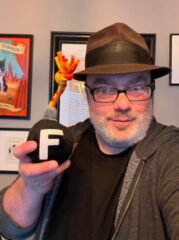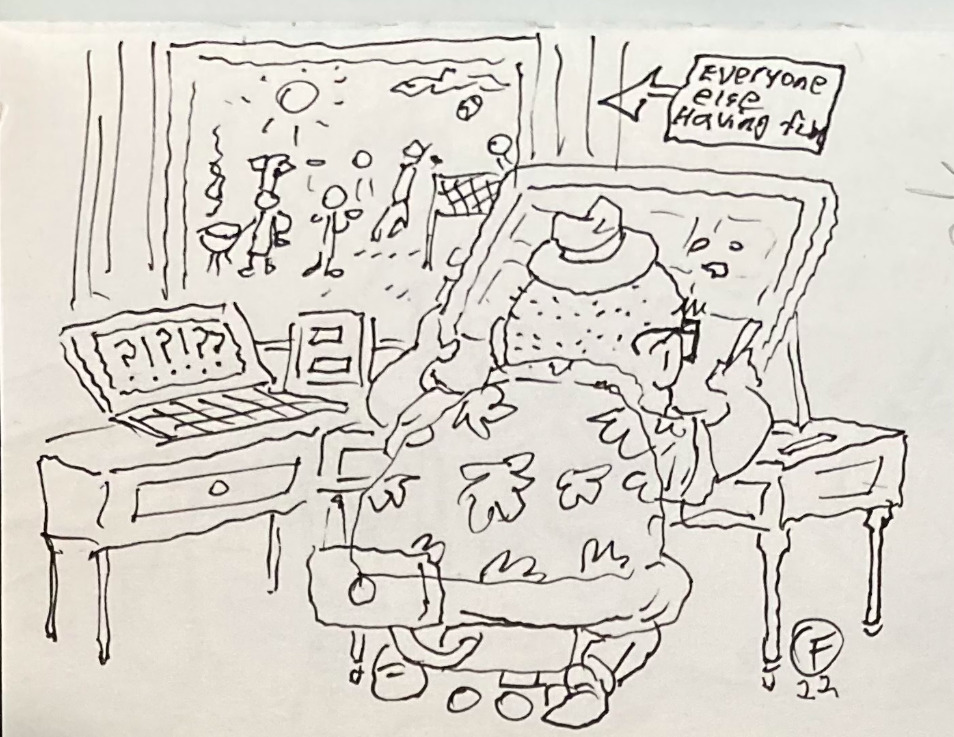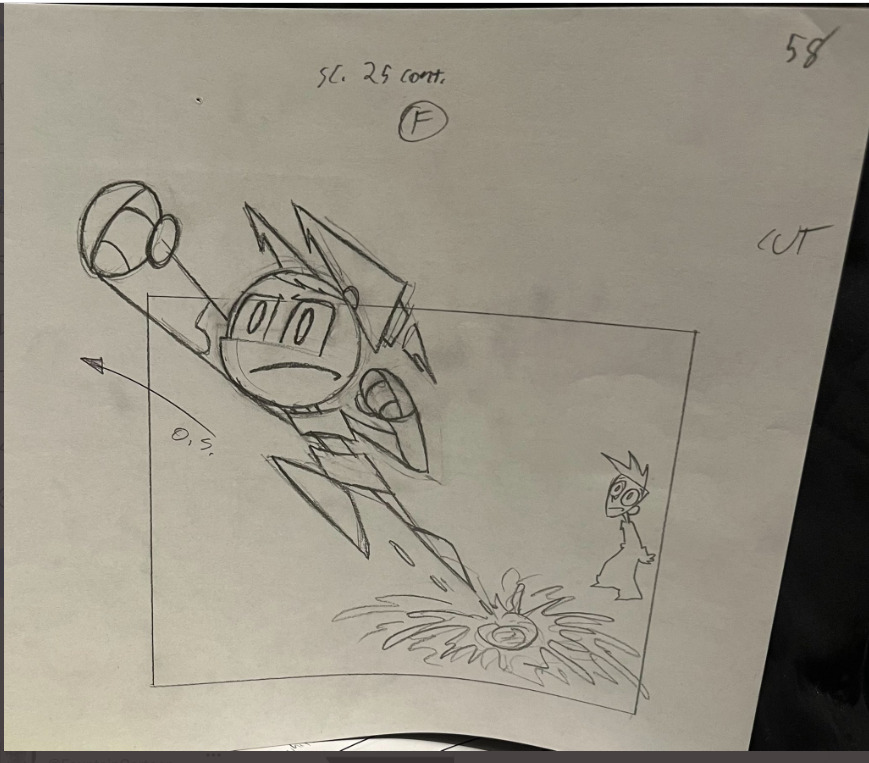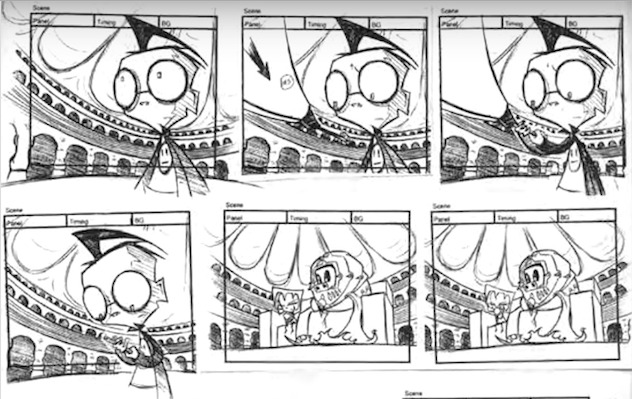A few weeks ago, animation veteran John Fountain who has worked for Disney, Nickelodeon, Cartoon Network and Warner Brothers on show such as The Fairly Oddparents, Invader Zim, Dora the Explorer, Angry Birds, South Park and Rick and Morty launched a “Storyboard 101” tutorial on Twitter. He was kind enough answer a few of our questions about his career and the fine art of storyboarding in animation:
Aniamg: Can you tell us how you got interested in animation?

John Fountain: I followed Bugs Bunny down that rabbit hole almost immediately after I left my mother’s womb! As a child of the 70s, I wasn’t particularly interested in the medium-brown corduroy existence that “reality” offered, so I spent as much time as possible worshipping at the altar of TV cartoons hoping that one day — if I watched them faithfully and unceasingly — they’d “accept” me and I’d get sucked into their world. But my primary show of dedication was to forsake all human interaction and spend every possible spare minute drawing. By the time I was about six, I think I had figured out that I couldn’t become a cartoon, so I decided to become the next best thing: a cartoonist!
How did you begin your career in animation?
John: The older I got, the less inclined I was to seek an actual “career” in “animation” as the technical process seemed incredibly tedious. Instead, I aspired to do newspaper comics and follow in the footsteps of my hero Charles M. Schulz wherein my original creations would be animated FOR me. As luck would have it, right around the 90s when I was in college, it became apparent that newspaper comics were breathing their last and I reluctantly took a job doing little odds-and-ends animation work for a local production company while self-publishing my own indie comics.
Strangely enough, that job led to a bigger job, which led to an even bigger one, and so on and so forth… eventually I found myself driving across the country from Michigan to Los Angeles with a modest portfolio, $100 to my name and no clue how to get a job in animation. Through a series of mind-boggling events, I landed my first in-house storyboarding job at Klasky Csupo for their new Nickelodeon series, The Wild Thornberrys.I had never storyboarded in my life.
But I’ve always had a determined attitude about whatever I do, so I immediately immersed myself in the craft in an effort to catch up with all of my experienced and learned peers. The entirety of “My story” is almost comically inspirational when told in full. For about a year, I actually toured various colleges and festivals doing a Tony Robbins-style presentation about how I managed to “achieve” with quite a few major obstacles in my way. But that’s another topic altogether.I got my shot, and I never stopped working to maintain it.

Why did you decide to offer tips and instructions on different aspects of the animation business?
Ultimately, I’m hoping to offer up the kind of guidance I could have used when I was young and struggling. Animation is a deceptively complex industry with a lot of legend, lore and moving parts… as such, when someone asks “How do I break into animation?” it’s almost impossible to give a useful answer without truncating it into the same old “work hard and eat your vegetables” kind of generic answer. My road was riddled with uncertainty, gambles and — yes — mistakes.
I guess my feeling is that I might as well take those experiences and put them to use so that maybe I can make someone else’s journey a little less perilous than my own. When I was touring colleges and doing workshops, I took a very “pull no punches” kind of approach, and I’ve been inspired by how many people have told me, “I’ve never heard it explained this way before” and “This is exactly what I needed to hear!”
I learned about the industry on the job – so I have a unique perspective that’s free of the “This is how it’s always been done!” ideology.

What is the question everyone asks about storyboarding?
Most people don’t ask about storyboarding! Storyboarding is mysterious and scary. Which is why I was dumbfounded when I took a Twitter poll and asked “What should my next long-form tutorial be about?” The choices were “Storyboarding 101” and “The Art of Storytelling.”
I was secretly hoping “Art of Storytelling” would win because it’s so much more ethereal and subjective – but “Storyboarding” won out by a narrow margin, so now I’m duty-bound to follow through, and to be honest, I’m intimidated and nervous about it. But in my experience, that’s usually when I know I’m doing something worthwhile. So… if my poll is any indication, the main thing people want to know about storyboarding is: “Just what the hell is it, anyway?!”

What is the biggest misconception about storyboarding?
That is centers around drawing. Drawing ability is helpful, to be sure, but I’ve always described my own drawing ability as “serviceable at best.” Storyboarding is filmmaking… and filmmaking is storytelling. The skills necessary to effectively tell a story are VAST and go way, WAY beyond merely being able to draw.

What’s the best advice you can offer about getting a job as a storyboard artist?
Get experience!I don’t care how you do it, but you not only need to be able to demonstrate that you can do the job, but that you can do it in a professional capacity — that is, meet deadlines, follow direction, work with a script, take notes from a client and myriad other things you only learn by “doing.”
This means being very creative and proactive in your quest… look for small production companies or local commercial houses… the need for storyboards is ubiquitous… make yourself available – be easy to work with… be better at it and more enthusiastic about it than anyone else… make yourself indispensable. Most importantly: Go to them! Don’t wait for them to come to you.
Who are your biggest animation influences?
Brad Bird. His entire philosophy for approaching a story is as close to my own as anyone I’ve ever seen and he conducts his work like symphonies with masterful confidence and grace. Any time I feel uninspired, I watch The Iron Giant and I’m reminded “that’s how it’s done.”
What do you love about your job!?
Coming up with creative solutions to seemingly unsolvable problems – of which there are MANY in animation. I’m currently working as the supervising director on a project with a quarter of the budget and a tenth of the resources as most productions, and it’s the most fun I’ve had in ages. I’ve come to realize that I love to look straight into a vortex of chaos and say, “I’ve got this!”
You can check out John’s helpful tips on storyboarding at twitter.com/FountainCartoon/




 Win a Funko X Lilo & Stitch Prize Pack!
Win a Funko X Lilo & Stitch Prize Pack! 
